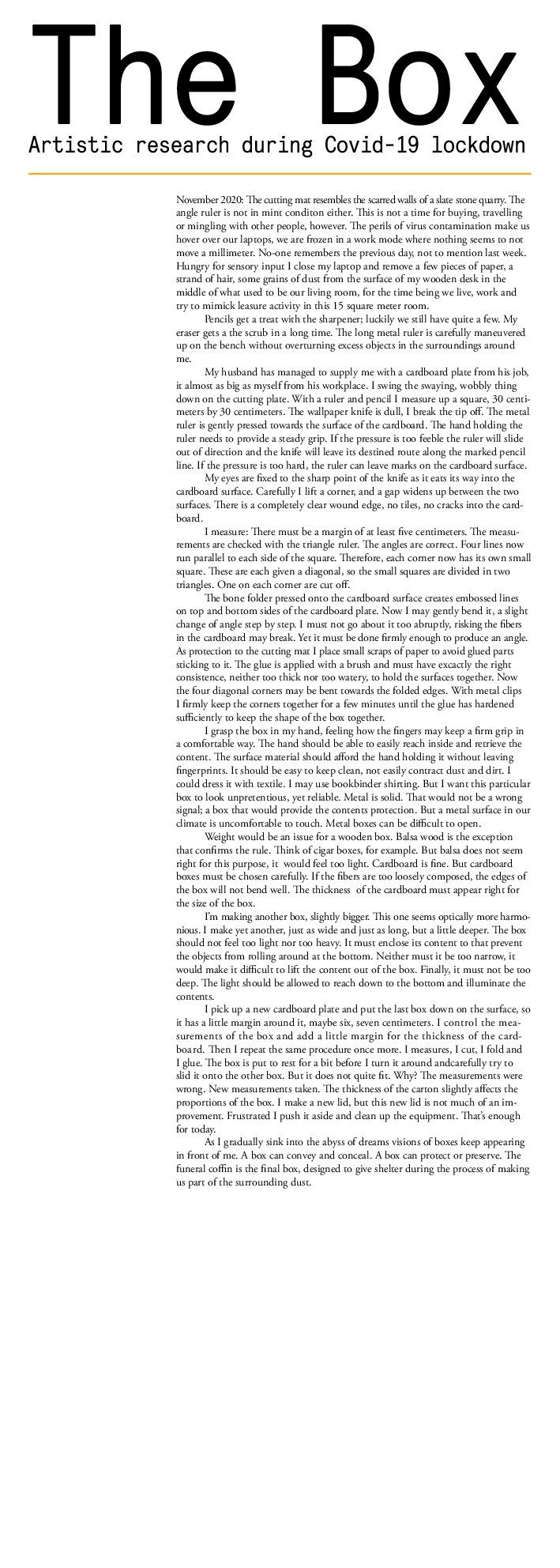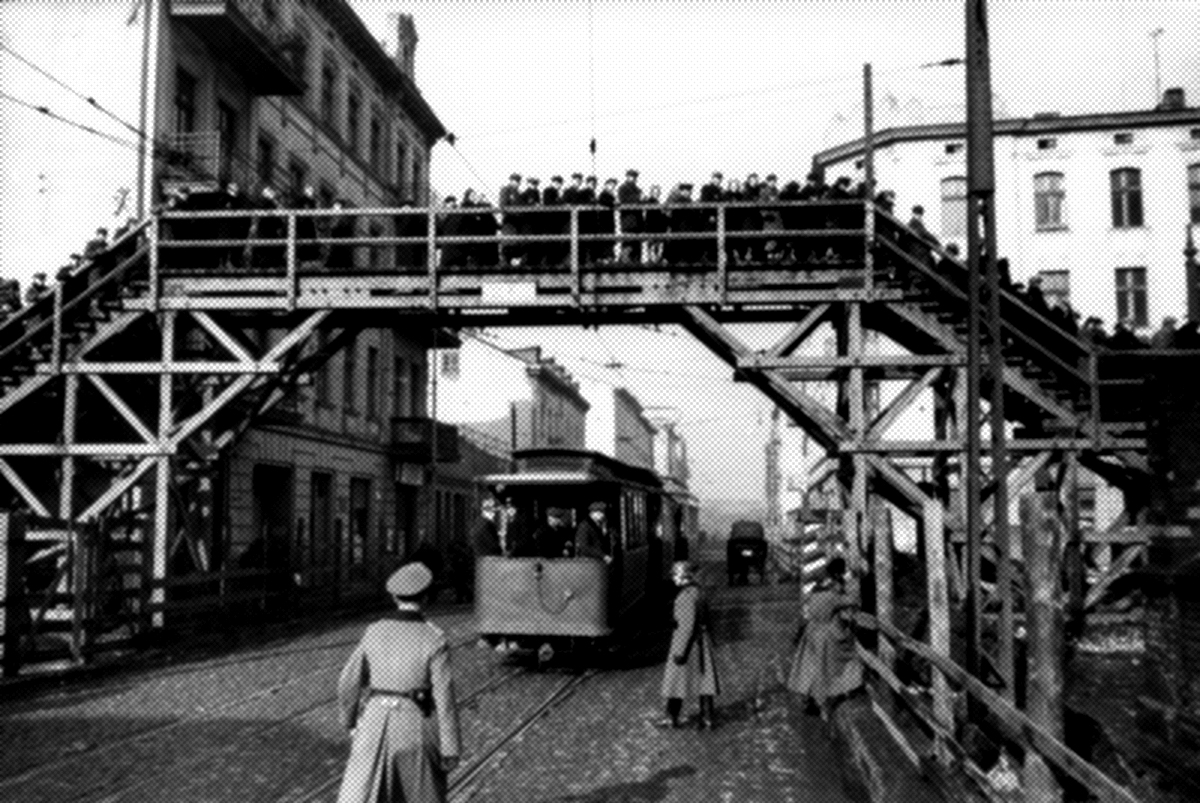This research is a shared project between professor Hilde Kramer (UiB) and book artist Imi Maufe. It is estimated to be concluded in spring 2022.
The text here should explain how the district Baluty was a state behind barbed wire. Seemingly autonimous, it was a sharade from the Nazi- German occupation forces to keep the Jewish population quiet while the Nazis prepared the extinction program killing 260 000 inhabitants between 1940 - 45.
What image material should we introduce at this stage?
We could film opening the Unfortunates as well as Jenta med heilt mjuke.
Since Imis text has been published in the.
Beginning as a project of exploring new ways of conveying the Holocaust, this project builds on WWII history from the Litzmannstadt ghetto in Lodz. It examins the artist book as carrier of complex non-fiction content and the narrative potential of illustrations as three-dimensional objects.
In recent years a cross-fertilization between industrially produced books and the artist book has taken place (Ommundsen 2014). However it should be underlined, that by going too quickly into a specific design direction, the risk is that the artistic research becomes constrained by technical limitations. If this project had been a commisioned work for mass production both development costs and material exploration would have been too expensive. Technical limitations of commercial book publishing and standard production deadlines would also make the research less open.
The materiality and spatial affordances of the construction of the book
How often do you find a mass-produced book that reminds you that every book is a multy-sensory experience? The books volume, colour and materiality is perceived by our eyes, the ink, glue and paper by our nose, the surfaces and spaciality by our hands. Artist books often apply unconventional methods of folding and binding and use these aspects as conceptual elements of their construction.
How will this book be used? must be the initial question from a design perspective. Who is the intended reader, and in what kind of settings will it be read? How will the reading process unfold? The intention behind this project is 'to bring human challenges to the forefront of todays society', to quote the index page. It is developed with the intention to bring understanding of how the children from Litzmannstadt ghetto lived and died during the Naz-German occupation. The book is intended to be read in museums, in libraries where it could afford multiple-reading situations, where groups of young people and adults would gather in a group to read and discuss its content.
Grasping in the sense of understanding has been used metaphorically and conceptually in the pilot project; by grasping a stone one could commemorate and fixate a memory of another human being who died during the Holocaust. The eye may see the book before we open it. We may sense the smell of printing ink, of binding material of paper fibre before we touch it. But gripping or grasping a book is the first physical contact between the book itself and the reader. There are certain elements then that come into consideration; how does the surface of the binding interact with the hand? Does it feel like a rejection, is it an indifferent experience or does the material seem inviting to the hand? In the process several different materials have been considered. Wood is an inviting material to the skin, and certain types of wood also have pleasant scent, but a box could easily become too heavy and take too much volume, metal could provide solidity through transportation and is appealing to look at, but cold metal is uncomfortable to touch and metal boxes are often difficult to open. This box must afford a certain lightness; it should not be lost or dropped easily, spilling the content. It should be easy to open and feel comfortable to the skin. It should have a balance between solitity, wear and tear. But it should also not be perceived at exclusive in terms of using leather or other expensive shirting materials. In short; a cardboard box was found to be the most appropriate. But also the size of the box matters, how easily it is to carry and hold during a reading session, and how deep it would be is of importance: A deep box may contain more objects, but it is difficult to see the content. A relatively flat box where light enters to give overview of the content is preferred.
A reading experience of non-linear order
In the pilot, participants drew the stones in commemoration workshops. The stones were given name tags and placed on the map according to where the commemorated children lived. From this material twelve children identities will be chosen, the information developed into short biographies. Reading all the twelve stories should give an insight in what living conditions the children from the Litzmannstadt ghetto experienced, and how the daily life of the ghetto was carried out. The book may be read in random order.
The intention behind this project is to present material through illustrations and accompanying factual text, as one would find in a traditionl non-fiction picturebook. It should educate, but do not preach, a strategy often found in concept books (e.g. Shaw1947, ) What can be gained through unconventional formats and choice of materiality? The novel The Unfortunates by B.S Johnson (1969) was an experimental book-in-box with 27 unbound sections with a first and last chapter. Allowing the reader to connect the content in multiple ways - actually 15,511,210,043,330,985,984,000,000 different ways of reading (Hooper 2014).
The semiotic structures of narrative picturebooks and their narrative structures have been widely discussed (e.g. Nodelman 1998, Sipe 1988, Nikolajeva and Scott 2001, Kümmerling-2014), however non-narrative picture books have rarely been considered from a similar viewpoint, to quote Smiljana Narančić Kovač at the conference Verbal and Visual Strategies in Non-Fiction picturebooks in Bergen autumn 2019. In her presentation she concluded that "the semiotic structure of a non-fiction picture book is analogous to that of narrative picture books, but that non-narrative picture books also differ from narrative picture books in their orientation towards factual content which results in their goal to evoke reality, and to offer readers reliable information about the world they live in" (Kovač 2019).
Illustration as semiophor
Illustrations used to be printed in magazines, posters, newspapers and books. With the media revolution, illustration is no longer confined to traditional tools and methods of multiplying. Can illustration even be three-dimensional objects? How may such an approach influence the reader's experience?
Illustrator Inger Lise Belsvik used three-dimensional objects as illustrations in the picture book Jenta med heilt jamne, mjuke augebryn (Sortland & Belsvik, 2008). The book was developed for people who are visually impaired as well as readers with full vision, the text printed both conventionally and in braille, Every spread carried an object that would reflect parts of the narrative; a ceramic stone, bird feathers resembling eye-brows etc. However the reading order was linear and the objects were glued to the right page of the spread, which would only allow partial haptical and visual inspection.
The term semiophor ( Semiophor ( Alt Gr. Σημεῖον semeion , character ',' signal 'and φορός Phoros , carrying') was introduced in 1988 by the French-Polish historian Krzysztof Pomian as a technical term in museum context, the term emphasizes the property of an exhibited object as a special sign bearer whose meaning first emerges from the context of the museum (Pomian, 1988).
In our project, we research what happens when we apply different three dimensional objects to our Non-Book: Such as a measuring tape; a common tailor’s tool can become a sign of the many tailors that became forced laborers in the Litzmannstadt ghetto. The object transforms its meaning and then becomes a semiophore from the everyday object. In this new function, it testifies to certain events relevant to these forced laborers (resemiotization). The original meaning, f.ex as a piece of measuring, however, fades (desemiotization). Semiophors are things whose meaning is not only in their material value, but in the testimony they give.
Performativity
The performativity of the book box will be tested as: a) one-reader experience, b) performer as role play, c) stage performance. Work methods here are 3D printing, various graphic techniques, exploration of materials to be transformed into three-dimensional illustration and more (Kiefer, 2011; Schaeffer, 2013; Silva, 2018).
REFERENCES
Primary sources
Dobosz, A. (2018, July). Czysta woda/ Clear water. Exhibition at BWA Krakow. Krakow, Poland: BWA Gallery.
Moniker. (2015). Place a Stone. Retrieved from Studio Moniker: https://placeastone.nl
Shaw, C. G. (1947) It Looked Like Spilt Milk. San Francisco: Harper & Row.
Sortland, B & Belsvik, I.L.(2008) Jenta med heilt jamne, mjuke augebryn. Oslo: Solum.
Secondary sources
Hooper M (2014) Why B S Johnson suits the digital age. In The Guardian 2014 10 14. https://www.theguardian.com/books/booksblog/2014/oct/14/why-bs-johnson-suits-digital-age
Kiefer, B. &. (2011). Nonfiction Literature for Children: Old Assumptions and New DIrections. I S. Wolfs, K. Coats, & P. &. Enciso, Handbook of Research on Children's and young Adults Literature (ss. 290-299). New York & London: Routledge, Taylor and Francis Group.
Kovač, S.N. (2019) A semiotic model of the non-narrative picturebook. https://www.hvl.no/contentassets/dc40436277f543dc9c39ea38e196f459/picturebooks_conference_2019.pdf p. 55
Ommundsen, Å. M. (2014). Picturebooks for Adults. In I B. Kümmerling-Meibauer Picturebooks: Representation and Narration, (ss. 17-35). New York: Routledge.
Pomian, K. (1988) Der Ursprung des Museums. Vom Sammeln. Wagenbach, Berlin 1988, ISBN 3-8031-5109-0 (= Kleine kulturwissenschaftliche Bibliothek, Band 9)
Schaeffer, J.-M. (2013). Fictional vs. Factual Information. Hentet fra The Living Handbook of Narratology: http://www.lhn.uni-hamburg.de/node/56.html
Silva, S. d. (2018). Play in Narratives for Children: On the "Rules " of a New Fiction. I A. Ramos, & S. &. Cortez,Fractions and Disruptions in Children's Literature (ss. 246-261). Newcastle upon Tyne: Cambridge Scholars Publishing.



